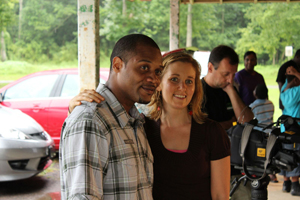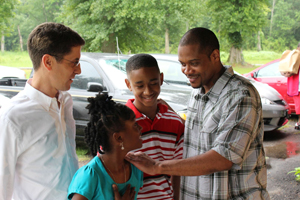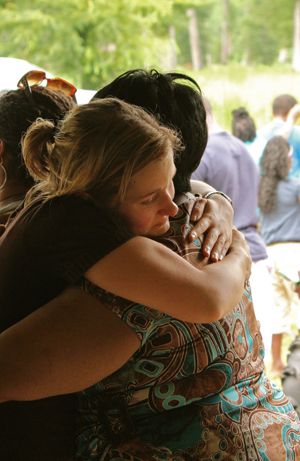Correcting an injustice
August 10, 2011
ATLANTA -- Visitors to Atwood Water Park along the Pearl River in Monticello, Miss., on July 23 wouldn’t have noticed anything extraordinary about the party for Cory Maye taking place under the pavilion. But it wasn’t a birthday or a family reunion; it was a long-awaited, hard-fought homecoming. After 10 years in Mississippi’s prison system for a crime he did not commit, Maye was once again a free man.
 Among the crowd of friends and family celebrating Maye’s release was Georgia State University law professor Jessica Gabel, who played a large role in getting Maye off of death row and out of prison. Gabel was part of a pro bono legal team from Washington, D.C.-based firm Covington & Burling that joined Maye’s defense counsel in 2006.
Among the crowd of friends and family celebrating Maye’s release was Georgia State University law professor Jessica Gabel, who played a large role in getting Maye off of death row and out of prison. Gabel was part of a pro bono legal team from Washington, D.C.-based firm Covington & Burling that joined Maye’s defense counsel in 2006.
“When I read the transcript [of the trial] it just reminded me of everything I went to law school to do,” says Gabel of the first time she heard Maye’s story. “There was this grave injustice, and I couldn’t not be a part of [the case].”
It was the night after Christmas, 2001. Maye and his 18-month-old daughter, Ta’corianna, were asleep in their duplex apartment in Prentiss, Miss.; his fiancée, Ta’corianna’s mother, was working a night shift at a factory in Hattiesburg. Maye was jolted awake by the sound of someone attempting to break in at the back door.
Fearing for his daughter’s safety, he grabbed and loaded the handgun he kept in the nightstand. When armed men burst through the back door and into the bedroom, Maye fired three shots into the darkness, killing one of the intruders.
 What Maye thought was a band of burglars was actually a team of policemen conducting a SWAT-style drug raid on the duplex. The search warrants they had obtained suggest that Maye’s neighbor in the other apartment, described as a “known drug dealer,” was the intended target of the raid; Maye had not been named.
What Maye thought was a band of burglars was actually a team of policemen conducting a SWAT-style drug raid on the duplex. The search warrants they had obtained suggest that Maye’s neighbor in the other apartment, described as a “known drug dealer,” was the intended target of the raid; Maye had not been named.
A doting young father with no prior criminal record, Maye was charged with capital murder, for knowingly killing a peace officer. He maintained his innocence throughout the proceedings, insisting that he was only trying to protect his family and did not know that the men entering his home were law enforcement. Maye was convicted and sentenced to death in 2004.
Journalist Radley Balko was researching a paper on the increased use of paramilitary police tactics for the Cato Institute, a policy think tank in Washington, D.C., when he came across Maye’s case. “It just kind of jumped off the screen at me,” Balko says. “Here’s this guy who had no criminal record… it made no sense why this guy would knowingly take on a team of raiding police officers, shoot and kill one of them and then surrender with bullets left in his gun.”
Gabel credits Balko with bringing Maye’s case to national attention and getting outside attorneys involved in Maye’s defense. Balko wrote about the case on his blog as soon as he discovered it in late 2005, and the story quickly proliferated across the Internet.
Abe Pafford, a young associate with Covington’s D.C. office, saw a post online linking to Balko’s coverage and was immediately taken with the story – he had a toddler himself. Pafford brought the case to the firm’s pro bono coordinator, and soon they were assembling a team to go to Mississippi. Gabel, in Covington’s San Francisco office, was brought on for her experience in forensics and death penalty cases.
 Several months prior to Gabel, Pafford, and another D.C.-based attorney, Ben Vernia, beginning on the case, Maye’s family fired his attorney and the trial judge appointed Bob Evans to represent Maye post-conviction. Evans had been the county public defender first appointed to Maye’s case in 2001, but ultimately the Maye family hired a private attorney who had little experience in criminal cases and no experience with a death penalty case.
Several months prior to Gabel, Pafford, and another D.C.-based attorney, Ben Vernia, beginning on the case, Maye’s family fired his attorney and the trial judge appointed Bob Evans to represent Maye post-conviction. Evans had been the county public defender first appointed to Maye’s case in 2001, but ultimately the Maye family hired a private attorney who had little experience in criminal cases and no experience with a death penalty case.
Over the next nine months, the new defense team partnered with Evans and reinvestigated every facet of Maye’s case, conducting interviews, enlisting new experts and investigators, re-evaluating the forensics and ballistics, and more. In September 2006, Gabel and her colleagues had a hearing in front of the judge: Maye was immediately removed from death row, where he’d been held for more than two years, but his conviction stood.
The case proceeded to the Mississippi Court of Appeals, which, in November 2009, reversed Maye’s conviction. This result was affirmed by the Mississippi Supreme Court in December 2010. The court held that Maye was entitled to a new trial because the trial court had improperly refused a jury instruction that would have highlighted Maye’s legal right to act in defense of his infant daughter on the night of the shooting. The defense team began preparations for a September 2011 trial.
 By this point each of the Covington attorneys on the case had moved on from the firm – Pafford and Vernia to their own practices, and Gabel to Georgia State – but they all continued their work on Maye’s defense. Gabel brought the case into the classroom, working with her forensic evidence students on trial preparations such as developing a list of potential experts for the upcoming trial.
By this point each of the Covington attorneys on the case had moved on from the firm – Pafford and Vernia to their own practices, and Gabel to Georgia State – but they all continued their work on Maye’s defense. Gabel brought the case into the classroom, working with her forensic evidence students on trial preparations such as developing a list of potential experts for the upcoming trial.
“All of May and June [this year] we were working hard on getting the forensics together,” Gabel says. “It was great to have students involved in it so that they too can have that experience and take it with them, and maybe down the road get involved with these cases more.
“We were working to reunite a man with his family, so it was all the more precious and important, experience aside.”
In late June, the prosecution hinted at the possibility that they might be willing to accept a lesser plea and bless Maye’s immediate release from prison rather than try the case again. After several rounds of negotiations, Maye pleaded guilty to negligent homicide and was sentenced to 10 years in prison on July 1. Having already served nearly that much time, Maye had only to be processed before he could go home.
Maye’s legal team – Gabel, Pafford, Vernia and Evans – and Balko were all at the park on the Pearl River to welcome him home in late July, a few days after he was released and reunited with his family.
“It was the last chapter in a case that has become so dear to my heart,” Gabel says. “It was a long journey, so it was incredibly emotional and gratifying watching him hug his mom and his children. It’s heartbreaking, given that he’s lost 10 years, but also so beautiful to see a family reunited and starting over from scratch.”
Contact:
Kathleen Poe Ross
University Relations
404.413.1374